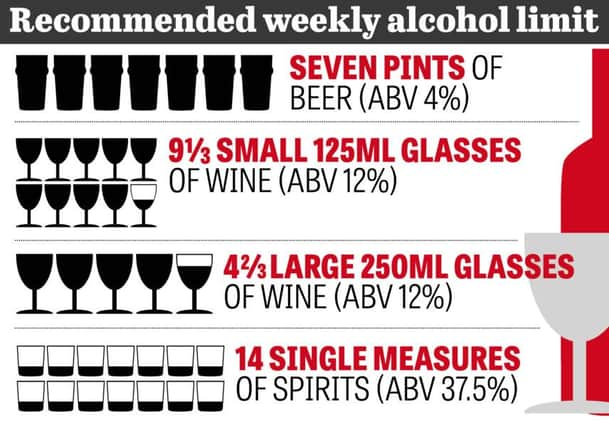Seven drink weekly limit in new alcohol guidelines


The advices advises that it’s safest not to drink regularly more than 14 units per week, to keep health risks from drinking alcohol to a low level.
If you do drink as much as 14 units per week, it is best to spread this evenly over three days or more. If you have one or two heavy drinking sessions, you increase your risks of death from long-term illnesses and from accidents and injuries.
Advertisement
Hide AdAdvertisement
Hide AdThe risk of developing a range of illnesses (including, for example, cancers of the mouth, throat and breast) increases with any amount you drink on a regular basis.
If you wish to cut down the amount you’re drinking, a good way to help achieve this is to have several drink-free days each week.
There is also advice on limiting the total amount of alcohol you drink on any occasion:
Drink more slowly, drinking with food, and alternating with water.
Advertisement
Hide AdAdvertisement
Hide AdAvoiding risky places and activities, making sure you have people you know around, and ensuring you can get home safely.
Binge drinking is, understandably, discouraged. Evidence shows that the “risks accelerate” from the point at which around five to seven units are drunk in one sitting. This includes the risk of accident or injury.
As well as the risk of accident and injury, drinking alcohol regularly is linked to long-term risks such as heart disease, cancer, liver disease, and epilepsy.
And if you are pregnant or planning a pregnancy, the safest approach is not to drink alcohol at all, to keep risks to your baby to a minimum - although the risk of harm to the baby is likely to be low if a woman has drunk only small amounts of alcohol before she knew she was pregnant or during pregnancy.
Advertisement
Hide AdAdvertisement
Hide AdWomen who find out they are pregnant after already having drunk during early pregnancy, should avoid further drinking, but should be aware that it is unlikely in most cases that their baby has been affected.
What has changed?
The last official guidelines on drinking were published in 1995 and much has changed since then. Numerous studies have shown that alcohol is linked to cancer, with even low or moderate levels raising the risk of seven types of cancer, including breast, mouth and bowel cancer. While the absolute risks may be small, the general agreement is that there is no longer a “safe” drinking limit for alcohol. But, taking account of the fact that many people do enjoy a drink, the UK’s chief medical officers have said that the risk of disease can remain “low” if people drink 14 or less units per week.
Examples of the recommended weekly intake of 14 units of alcohol:
14 single measures of spirits (ABV 37.5%)
Seven pints of average-strength (4%) lager
Nine and one-third 125ml glasses of average-strength (12%) wine
Seven 175ml glasses of average-strength (12%) wine
Four and two-thirds 250ml glasses of average-strength (12%) wine